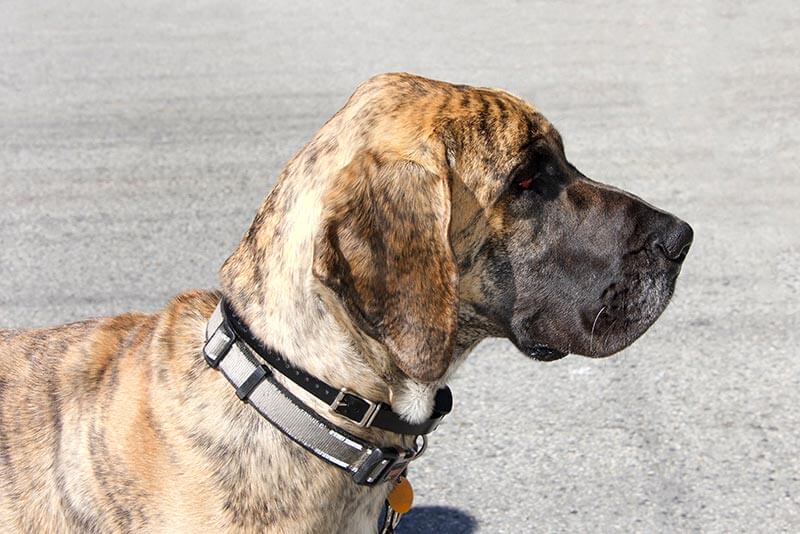
This post contains affiliate links and I will be compensated if you make a purchase after clicking on my links.
If you already have a Great Dane or are thinking about getting one, then having a great training collar should be top of mind. When we got our first Great Dane we knew that training would be incredibly important. Not to say that the training of all dogs is not important, but Great Danes are quite literally a different animal.
While Great Dane puppies start out small and cute, they will quickly grow into very large and powerful dogs. An untrained Great Dane can harm not only themselves but also those handling them. Next to a leash, a good training collar is one of the most important tools for training your Great Dane.
The training collar that we recommend for Great Danes is the Garmin PT10. We love it for its waterproof build, multiple-mode support, fantastic battery life, and one-mile (1600 m) range! As a testament to its durability, ours is over four years old and has never had a single problem. While there are more advanced models available, we feel that the Delta PT10 offers the perfect blend of features and cost.
Customize your dog training experience with the versatile and easy-to-use Garmin training collar. With improved stimulation levels, it's the perfect training tool at home or in the field!
Types of Training Collars
While there are many types of training collars, I will only be covering those most commonly used in Great Dane training.
Also, keep in mind that a Great Dane training collar is not meant to replace a flat collar. Flat collars are still extremely useful for holding identification tags or making your Dane more stylish!
Martingale
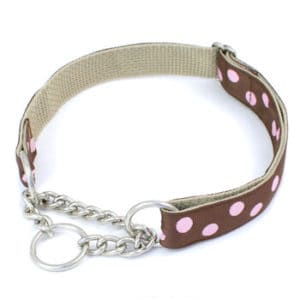
Compared to a flat collar, the martingale collar is a big upgrade for training. It has dual loops and is able to tighten as needed.
The outer loop is often made of nylon, while the inner loop is a metal chain that allows it to expand or contract as needed. The play in the chain is fixed to limit the amount of pressure that can be applied.
The extra pressure gets automatically applied in the event that the dog starts pulling on their leash, or should you provide correction. The collar immediately loosens once the tension is released.
For dogs with heads smaller than their necks, this is very useful to prevent the collar from slipping over their heads. Thanks to Great Dane’s large heads, this is not an issue that often needs solving!
Prong or Pinch Style
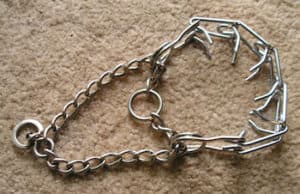
Prong or pinch style collars are what probably comes to mind when you think of a “training collar”. They have been around for a long time, but are considered somewhat old school these days.
When pressure is applied via the leash, the blunt prongs contract against the dog’s neck. Unlike choker chains, they also have an inner loop that limits how tightly they can contract.
In addition to quickly getting a dog’s attention, the prong style is thought to mimic their mother’s corrective behavior. The quick snip at their neck is thought to closely resemble how a mother will correct her young to induce correct behavior.
While they have been used for a long time in the training of Great Danes, there are better options available today.
E-Collars
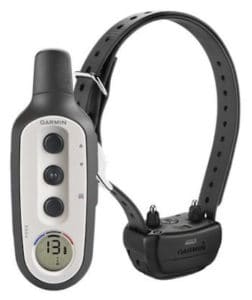
E-collars are also known as electronic collars, remote training collars, and shock collars. Unfortunately, e-collars have received a bad stigma due to a misunderstanding of the technology.
They function by using electronic stimulation, not electric shock. This is done by passing an electric current through the tissue, causing a tingling or pulsing sensation.
If you’re still not convinced of the difference then consider the fact that electronic stimulation is used as therapy for humans!
One form, known as EMS, is often used for therapeutic recovery from injuries as well as for recovery from training by athletes. An alternate variation known as TENS is used to treat chronic and acute pain.
E-collars are fantastic because they allow you to immediately get a dog’s attention. They also do so without the risk of damaging their necks through pulling as can be seen with martingale and prong-style collars.
In addition, they have the added benefit of extreme range. Compared to the physical limitations of a leash, you can issue and correct commands from much longer distances. This is especially useful in training recall (come), as well as many other commands.
It should also be noted that e-collars also exist to combat excessive barking, and not just for standard training. Some function by automatically emitting a noise when the dog barks.
Others will also use electronic stimulation to stop the barking behavior. For some breeds, this is a key feature but is not needed for most Great Danes.
Key Selection Criteria For E-Collars
As with many goods these days, there are a wide variety of options to consider when selecting an
- Recommended dog size – Some collars are not intended for larger breeds and as such may not provide sufficient stimulation.
- Neck size – Most adult Great Danes have necks that range from 20 – 26 inches (50 – 66 cm) in circumference. Make sure that any collar you select supports the long end of this range to ensure that they don’t grow out of it as adults. On the low end, is also needs to get small enough to support them in the all-important puppy training phase.
- Available training modes – Good models offer a variety of modes to provide correction. Commons ones include a beep or other noise emission, vibration, and electronic stimulation. All good models should also have a range of electronic stimulation that can be dialed up or down accordingly.
- Range – One of the primary benefits of an
e-collar is the range it provides to allow for correction. Knowing that manufacturers list ranges for ideal conditions, I wouldn’t recommend purchasing a model with a range less than a quarter mile (400 m). - Waterproof – Unless you plan to field train your Great Dane then they may not spend much time directly in the water wearing their e-collars. However, it is good to know that the device won’t die after getting wet in the rain, running through a sprinkler, or Fido’s drool!
- Battery life – If there’s one downside to an
e-collar , it’s the need to charge it. For this reason, I recommend staying away from cheaper variations, as they will likely need to be charged on a daily basis. The likelihood of the battery dying sooner is also higher due to the cheaper battery materials used. - Multi-collar support – If you plan to have multiple dogs then you certainly don’t want to also carry multiple collar remotes. Top collars these days come with remotes that can be paired with multiple collars. This allows you to use the single remote to control several collars and can save you money by not needing to purchase a remote each time.
- Warranty – While you shouldn’t expect a collar to fail, a warranty makes for great peace of mind. Knowing that the manufacturer will replace the device in the event of unexpected failures also helps justify spending just a little bit more upfront.
Based on these criteria and our own fantastic experience of using it for years, I’ve stuck with using Garmin PT10 for years and have no plans of changing anytime soon!
Customize your dog training experience with the versatile and easy-to-use Garmin training collar. With improved stimulation levels, it's the perfect training tool at home or in the field!
Training Schools of Thought
I should point out that there are multiple schools of thought when it comes to training. Some forms include positive reinforcement, corrective reinforcement, clicker training, and relationship-based training to name a few.
Bring this up at a dog park and you’re sure to stir up quite the controversy!
The fact of the matter is, that all of these forms have their own pros and cons. In fact, the best “method” of training likely combines elements from multiple types.
I’m not here to judge you or tell you what the right way is, but I will say that it’s incredibly important that your Great Dane be well-trained. Regardless of which camp you fall into, a good training collar is a fantastic tool for training.
In addition to training collars, many owners also choose to invest in other types of collars for added functionality. From GPS to activity tracking, there are many options out there.
One that I find offers a fantastic blend of many of these features is the


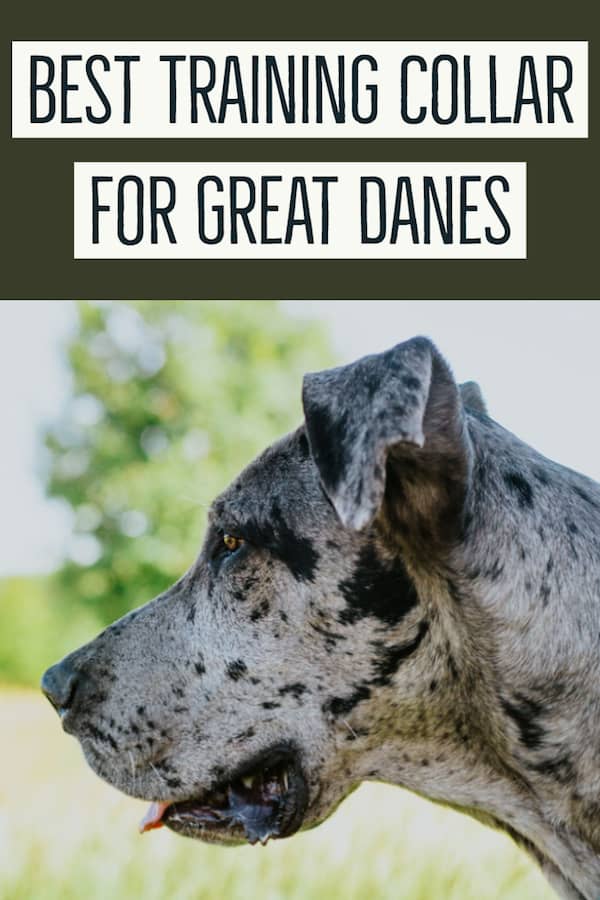
I have read a lot on your site, one thing I was wondering is about the age to use the Ecollar with, as “Tank” my Dane is now 5 months old he’s getting quite large and Strong, the collar I bought says to use on 6 months or older however I used it today not realizing it suggested that. Usually when we walk he starts out great with the “easy” command for the loose leash, however whenever we are headed back he pulls constantly and I was afraid he will get too strong for me, so I used the collar today on Vibrate mode and it was a world of difference, I never had to hold down the button for any length of time he responded immediately, and I even had to take up the leash slack so it wouldn’t tangle in his legs. Do you think it was too early for me to use?
Sounds fine to me!
I used one on mine when she was like 4 or 5 months old. I think it just means size wise imo. So a 4 or 5 mon5h old great dane is equal to a 9 or 10 month old regular size pup so you are fine
Zack
This my first time with a Great Dane. I have all ways wanted one and it has been a real joy with him in are family but lately he has been a little unruly. I have read about needing to get a training collar. He dose ok at first on the leash but a little latter he starts to pull and wants to meet anything he can would you be able to give any suggestions on how to be a better owner and have a well behaved Dane thanks for your time.
I’m a first time Dane parent, and I have used a gentle lead for my lab, would a gentle lead be a good device for leash training a Dane?
Hi Zach,
My husband and I tried to purchase the E Collar you recommended, Garmin Delta XC Dog Training Collar Bundle, but it seems to be unavailable on Chewy and Amazon. Could you please recommend another brand?
Thank you!